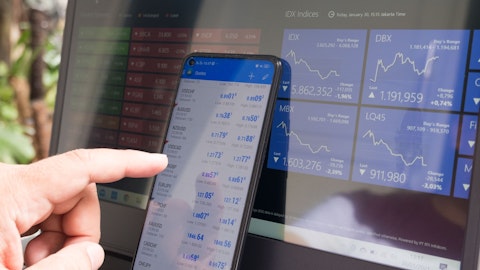Betsy Graseck: Hi and congratulations from my end too. And the deck is super clear. I really appreciate all the effort to make it simple and straightforward. So a couple of questions for me, just to follow-up on the discussion we just had. Could we also talk a little bit about how we should think about the reserving level as we go through 2023 and into 2024? Because like you said, you’ve got the fair value marks, you had to do the day, you had to do the add as per the CECL rules. So does reserve ratio stabilize from here? Does it actually inch down? Is there a scenario in which it would move higher? Could you just frame out how we should think about that? Thanks.
Terry Dolan: Yeah. I mean, obviously, it is impacted by a lot of different things in terms of how economic uncertainty ends up changing and the mix of the portfolio, how it might change. But as we think about 2023, I think that, that 191 basis points is probably a good — is a good metric throughout the year. It might inch down a little bit. But I think that, by and large, we feel pretty comfortable with that as we think about 2023 based upon our base case, so to speak.
Betsy Graseck: Okay. And then I have one other question on the growth of the balance sheet. I know you addressed this a bit before. But when I look at the 2023 guide versus 1Q 2023, it’s a slower growth rate than I think we’re used to seeing at USB. So maybe you could help us understand, is this a moderated growth rate during the integration phase and maybe second half that should accelerate up, or is this the level of growth that we should anticipate? And then if you don’t mind, I have just a couple of ticky-tackies on the purchase accounting and the CDI and how we should expect that steps down into 2023 and 2024.
Andy Cecere: Sure. Betsy, this is Andy. So first, on the growth rate, I think 2022 had exceptional loan growth across many categories, led by commercial as well as CRE. So what we would see is that more normalizing. You’re starting to see that in the fourth quarter. And I think the other fact is that, the growth rates are impacted by average balances and some of the optimization activity that we took down in the fourth quarter. It was a partial quarter in the fourth quarter, full quarter in the first quarter and the rest of 2023. But the principal driver is a function of loan demand, which is moderating a bit across most categories. So it’s still growing but a less than what we saw in 2022.
Terry Dolan: And then, Betsy, maybe related to your second question, which was around the recognition of the core deposit intangible over time, probably the way that I would think about it is that, it’s €“ it will amortize into income over about a 10-year period. It will step down, and probably a good way of just modeling it is assuming kind of a sum-of-the-years digit sort of approach.
Betsy Graseck: And same thing for PAA, or how should we think about that? I mean PAA, I know it’s different, but PAA change
Terry Dolan: Yeah. So that’s tied, obviously, to the life of the loans. And it will end up being impacted by prepayments and all sorts of things. If you end up looking at their portfolio that we acquired, about half of it is residential mortgage and half of it is corporate in shorter term. So probably, if you ended up looking at an average life of four, five years, four to six years, that sort of time frame, then of course, that will also accrete probably a little bit faster on the front end.
Betsy Graseck: Okay. Thank you for that.
Terry Dolan: Yep. Thanks, Betsy.
Operator: And next, we’ll go to Vivek Juneja with JPMorgan. Please go ahead.
Terry Dolan: Good morning, Vivek.
Vivek Juneja: Hi. Good morning. Congratulations. A couple of questions. The tangible book value recovery, the crossover and the fact that you’d recover that back quickly, can you just give any color on sort of what’s the key driver of that? Is it just simply earnings, or is there something else underneath that also that’s going to help that come back so quickly?
Terry Dolan: Yeah. It’s principally the accretion effect that we’re going to see with respect to Union Bank, the marks and the underlying earnings of the company.
Vivek Juneja: Okay. So the €“ because I just heard you say, the accretion €“ the question that Betsy asked, purchase current accretion that half the loans are mortgages. So that will take €“ come down, I guess, over more slowly? So is that part of it that pre-purchase accounting accretion is going to stay high for longer?
Terry Dolan: Yeah. No, I really think it’s just €“ it really is the kind of the 8% to 9% accretion levels that we’re expecting on €“
Vivek Juneja: The UB side?
Terry Dolan: Yeah.
Andy Cecere: Yeah.
Vivek Juneja: Okay. Got it. Okay. A couple of other little ones. Deposits, the decline that you had in the balance sheet optimization I think it’s pretty sizable, $24 billion. Is it all UB, or is it some of yours? And which types of deposits?
Terry Dolan: Yeah. It’s a great question. From a deposit standpoint, when you think about kind of the optimization that we went through, we had kind of a focus on a couple of different things. We ended up looking at LCR ratios. We ended up looking at higher-cost deposits, whether that would be brokerage-type deposits or euro dollar deposits, those sorts of things. We made a very conscious decision after getting regulatory approval to kind of reposition that. On the Union Bank side, the one thing that I would point out is that, there’s about $8 billion to $9 billion worth of deposits that came over that were more transitionary. And over time, those will transition back to their global investment bank as those customers, kind of, migrate.
So, about half of that migrated in the fourth quarter, and I would expect probably the other half of that to migrate in early 2023. But those are kind of the things we ended up looking at with respect to deposit and deposit flows. So, it was really looking at trading out low-cost deposits — or high-cost deposits for low-cost deposits that are coming over for Union Bank and then some of the Union Bank effect.
Vivek Juneja: And what was the OCI number at the end of the year? So, as we think about where — the going to Category II, how quickly do you expect that to come down so that you can be in better shape?
Terry Dolan: Yes. So, OCI at the end of the year is about $8 billion, and the duration of the portfolio is a little over 5%. So, if you can kind of take a look at that, obviously, that’s assuming that rates don’t move from here. Our positioning from an investment portfolio perspective is about 52%, 53% HTM. We’ve also entered into some pay fixed swaps that in effect kind of get that up to the high 50s. So, we feel like we’re in a pretty good position to be able to deal with — if rates move up a bit or if rates come down, we have some flexibility there as well. So, we feel like we’re in a pretty good spot.
Vivek Juneja: All right. Thank you.
Operator: And next, we can go to Matt O’Connor with Deutsche Bank. Please go ahead.





